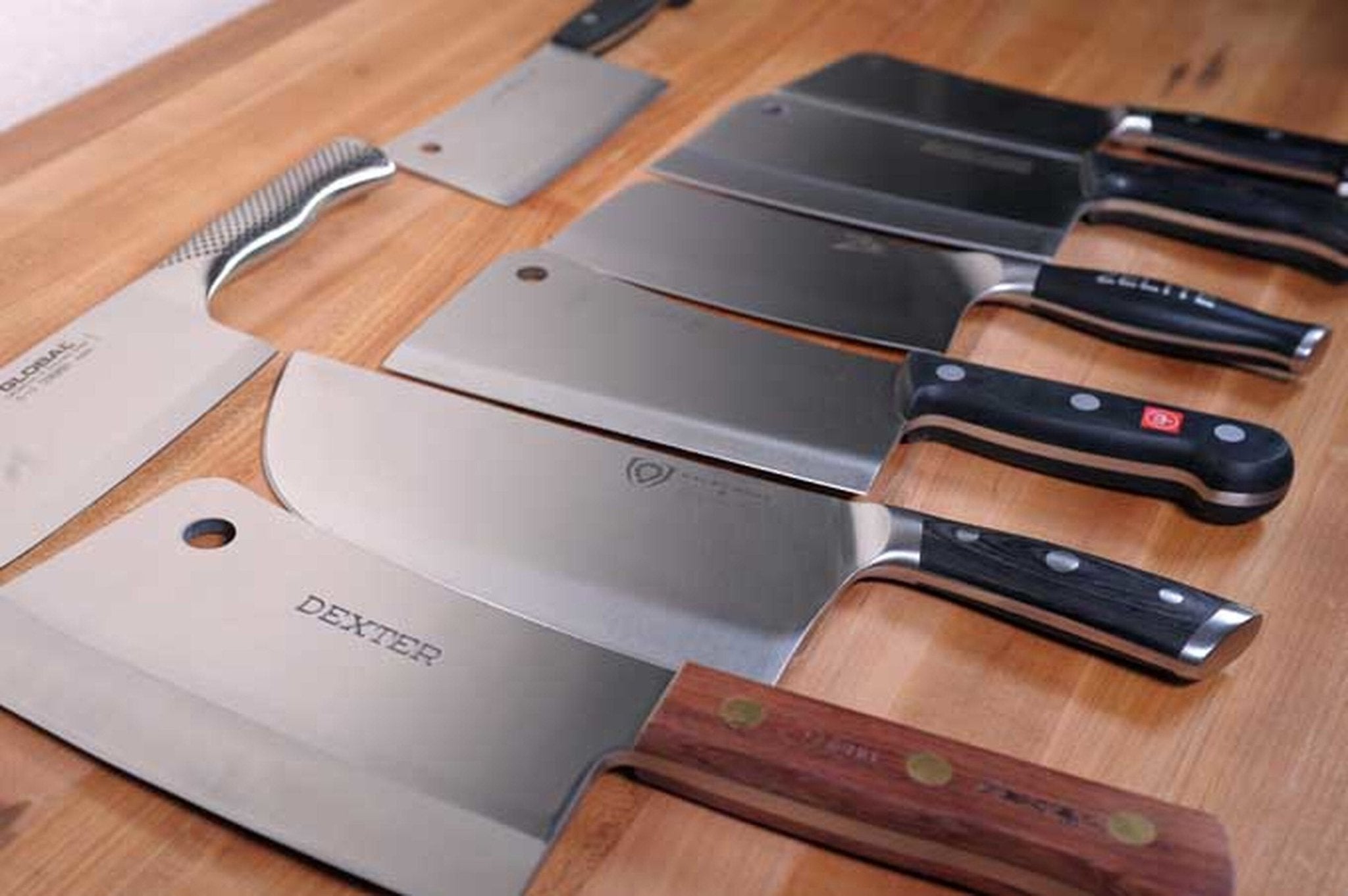The Benefits of a Meat Cleaver

Of all the knives you may have in your kitchen none is probably as well known by sight as the meat cleaver. It is one of the larger knives you are likely to purchase and depending on its shape can resemble a square-bladed hatchet.
However, there is more to this knife than just being able to scare your family with its size and look. In fact, the weight of the meat cleaver makes it the perfect tool for breaking down large pieces of meat into manageable chunks and chopping tough vegetables that your smaller knives just can’t handle.
The point is there are a lot of benefits to having a meat cleaver as part of your knife set.
How To Handle a Meat Cleaver
Before using any knife you should take the time to get familiar with its size, weight, and maneuverability. It wouldn’t be smart to assume you know how to handle a cleaver just because you have handled other knives in your kitchen.
The Right Grip

The first step is knowing how to grip your cleaver properly. Due to its size, there is more than one way to properly grip a meat cleaver.
One way to grip your meat cleaver is to take hold of the handle close to the blade. From there you will want to place your thumb on one side of the handle while curling your remaining fingers over to the opposite side of the handle.
A second grip that is similar to the first is more focused on the blade versus the handle. You will do the same as the first grip in that you will grip the handle where it is closest to the blade. From there you will place your thumb and index finger on either side of the blade. You will want to be sure that the main grip pressure is evenly distributed between your thumb and index finger.

This second grip is usually the one preferred by chefs as it gives the knife handler more control of the blade. However, if you aren’t cutting anything that needs any particular finesse, such as chopping vegetables, the first grip will work well.
What is the Hole For?
Another feature that you will quickly notice about the meat cleaver is the perfectly shaped hole in the blade. This isn’t really a fancy feature of the cleaver, but more a practical one. As meat cleavers are a favorite in the kitchen it stands to reason that a chef would want one within easy arms reach.
However, the job of the cleaver can be done rather quickly. This is why the hole is used to hang the meat cleaver on a nearby hook or even onto the chef’s belt loop when finished using it.
What Can a Meat Cleaver Do?
Though the more traditional task of the cleaver would be to section large carcasses in a butcher shop, there are a good amount of modern tasks that have come about for the meat cleaver in any chef’s kitchen.
Vegetables
A well-rounded knife set will give you the option of using a chef knife or paring knife to dice vegetables, but if you have a particularly tough-skinned vegetable the meat cleaver can be a great choice of knife.
- Chopping and Slicing

You might be surprised to learn that there are many ways to use a cleaver to chop, slice, or even dice your vegetables. For this task, you will want to grip your cleaver using the second form mentioned above to have the appropriate amount of control.
Using a smooth downward motion to cut the vegetable, you will then lift the cleaver all the way off the cutting board each time before taking it down again to make the next slice. A noticeably different technique than the one used with other knives.
- Crushing

Another valuable use of the meat cleaver is its ability to easily and effectively crush certain ingredients, such as garlic or ginger. In some instances, it is easier to get ingredients this way versus having to meticulously cut them out.
When crushing any ingredient it is important to place it on a cutting board and lay the wide side of the cleaver flat against it with the blade facing away. With your free hand, you can hit the top side of the blade to crush the ingredient. Make sure that you hit closer to the blunt edge and not the sharp edge to avoid any accidents.
- Transferring

With the cleaver’s wide blade you can use it to easily scoop up ingredients such as vegetables to transfer to a bowl or the stove. To do this you will want to rest the knife horizontally next to the chopped vegetables at a slight angle with the sharpest part of the blade facing away from you. Then quickly slide the blade under the vegetables while simultaneously using your free hand to push them onto the wide part of the blade.
From there you’ll be able to carefully take them from point A to point B with ease. You’ll want to use your free hand to anchor the ingredients on top of the blade to ensure they don’t spill. Just be careful not to place your free hand to close to the sharp end of the blade.
A Cleaver For Meat and Fish
After everything is said and done, what you will really want to use your meat cleaver on is, well, meat. A meat cleaver is a versatile tool that will allow you to tenderize, mince, slice, and even scale any meat you have in your kitchen. This especially handy when purchasing whole pieces of meat that still contain bone.
Sectioning Meat From The Bone

If there were one specialty that the meat cleaver is known for it would be its ability to cut through bone with ease. This is because of the way that the knife is built. Its large sharp blade edge is perfectly designed to cutting away flesh from the bone including fat and, if necessary, the skin.
The meat cleaver’s blade is also thick and made to handle the more heavy-duty tasks in the kitchen. Because of this feature, it can cut through small poultry bones in a snap. Additionally, even if you have a larger thicker piece of meat the cleaver can still give you the cut of meat you want.
Using the meat cleaver’s wide blade you can place the sharp edge where you want to cut into the piece of meat. From there you can use the blade’s own weight and your free hand to push down on the top part of the blade to slice right through.
Once you master cutting meat from the bone using a meat cleaver you may find that it is better and cheaper to purchase meat this way.
Scaling a Fish

While scaling a fish will take a bit more finesse than simply cutting into a large piece of meat it can still easily be done with the assistance of a meat cleaver. You will want to grip the cleaver using the second gripping method above so as to give you more control.
Place the fish you wish to descale onto a cutting board. While you hold the fish head with your free hand you will use the meat cleaver to slowly run the blade up and down the fish at a slight angle. Continue this process until you have successfully descaled your fish.
Keeping Your Cleaver Sharp

No matter what knife you use in your kitchen it is always important to keep your knives sharp. Remember, a sharp knife is a safe knife. When it comes to the meat cleaver there is no exception.
Due to repeated hard chopping and the need to cut through thicker meat, it is most important to keep your meat cleaver as sharp as possible. Having a sharp edge is also important if you intend to use your meat cleaver for more intricate work.
To do this you will want to sharpen your meat cleaver blade at a 20 to 30-degree angle using a whetstone. The more chop work you do thus adding pressure to the blade will be what determines how high of an angle you should sharpen your meat cleaver at.
A meat cleaver can quickly become one of your most valuable tools in your kitchen when used and cared for properly. That is why it is so important to fully understand how to use a meat cleaver and know all the benefits you can have by adding it to your knife collection.
Why Chef Sac?
Chef Sac develops chef knives, knife rolls, backpacks and kitchen accessories for chefs to safely transport their culinary tools. Most of our bags have a dedicated slot for the cleaver along with a safety strap to hold the knife in position. Get yours today!
0 comments



